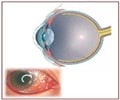Report says certain children with the visual condition known as retinopathy of prematurity appear to see better at age 6 if they received treatment early
A report that will appear in the June print issue of Archives of Ophthalmology, one of the JAMA/Archives journals says that certain children with the visual condition known as retinopathy of prematurity appear to see better at age 6 if they received treatment early, whereas others benefit more from observation than early treatment.
Retinopathy of prematurity occurs in babies born early; abnormal blood vessels and scar tissue grow over the retina, decreasing vision. A previous study on retinopathy of prematurity helped researchers identify two types of the condition—Type 1 and Type 2—based on various clinical characteristics, according to background information in the article. Differences between the two include stage of disease, area of the retina affected and the presence or absence of plus disease (severe growth of additional blood vessels in the back of the eye).In the previous study of 401 infants whose eyes were randomly assigned to early treatment or conventional management, early treatment appeared to show a benefit at 9 months. The Early Treatment for Retinopathy of Prematurity Cooperative Group followed the same group of children through 6 years of age (370 had survived).
Overall, early treatment was not associated with improved vision at 6 years. However, eyes of children with Type 1 retinopathy of prematurity appeared to have improved vision at age 6 if they were treated early (25.1 percent vs. 32.8 percent had an unfavorable outcome). There did not appear to be a benefit of early treatment for eyes of children with Type 2 retinopathy at age 6 (23.6 percent vs. 19.4 percent unfavorable outcomes).
In the original nine-month study, "the analysis identified eyes with characteristics indicating a benefit for early treatment (Type 1) and eyes that could be observed (Type 2), with treatment offered if the disease progressed to Type 1," the authors write. "These divisions into Type 1 and Type 2 eyes were not preplanned as part of the original design in 1999 but came about in 2003 as a result of analysis of initial study outcome data. There was an obligation to follow these eyes according to this subdivision once the types had been developed and published."
The results demonstrate that the benefit of treatment for children with Type 1 disease lasts as long as six years, they note. "Visual acuity is improved with early treatment, but nevertheless, 65.4 percent of eyes receiving early treatment develop visual acuity worse than 20/40. Whether this result is due to retinal, cortical or both factors remains to be determined, but clearly prevention of retinopathy of prematurity now assumes an even higher priority since early treatment is beneficial for some eyes but often does not result in normal development of visual acuity."
RAS
 MEDINDIA
MEDINDIA




 Email
Email




